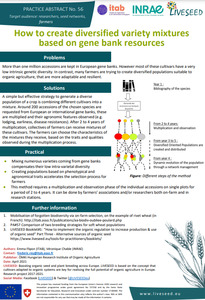{Tool} How to create diversified variety mixtures based on gene bank resources (Liveseed Practice Abstract). Creator(s): Flipon, Emma and Chable, Véronique. Issuing Organisation(s): ITAB - Institute for Organic Agriculture and Food, INRAE - National Research Institute for Agriculture, Food and Environment. Liveseed Practice abstract, no. 56. (2021)
|
PDF
- Published Version
- English
481kB | |
![[thumbnail of 2022-07-26 21_09_01-PowerPoint Presentation.png]](/39905/8.hassmallThumbnailVersion/2022-07-26%2021_09_01-PowerPoint%20Presentation.png)  Preview |
Image (PNG)
- Cover Image
- English
172kB |
Document available online at: https://www.liveseed.eu/wp-content/uploads/2021/04/PA56_How-to-create-diversified-variety-mixtures-thanks-to-the-gene-bank-resources.pdf
Summary in the original language of the document
Practical recommendations: Mixing numerous varieties coming from gene banks compensates their low intra-varietal diversity. Creating populations based on phenotypical and agronomical traits accelerates the selection process for farmers. This method requires a multiplication and observation phase of the individual accessions on single plots for a period of 2 to 4 years. It can be done by farmers’ associations and/or researchers both on-farm and in research stations.
| EPrint Type: | Practice tool |
|---|---|
| What problem does the tool address?: | More than one million accessions are kept in European gene banks. However, most of these cultivars have a very low intrinsic genetic diversity. In contrast, many farmers are trying to create diversified populations suitable to organic agriculture, that are more adaptable and resilient. |
| What solution does the tool offer?: | A simple but effective strategy to generate a diverse population of a crop is combining different cultivars into a mixture. Around 200 accessions of the chosen species are requested from European or international gene banks, these are multiplied and their agronomic features observed (e.g. lodging, earliness, disease resistances). After 2 to 4 years of multiplication, collectives of farmers can receive mixtures of these cultivars. The farmers can choose the characteristics of the mixtures they receive, based on the traits and qualities observed during the multiplication process. |
| Country: | France |
| Type of Practice Tool: | Practice abstracts |
| Keywords: | plant breeding |
| Agrovoc keywords: | Language Value URI English plant breeding http://aims.fao.org/aos/agrovoc/c_5956 |
| Subjects: | Crop husbandry > Breeding, genetics and propagation |
| Research affiliation: | European Union > Horizon 2020 > Liveseed European Union > Horizon 2020 > Liveseed > Liveseed tools France > INRAe - Institut national de recherche pour l’agriculture, l’alimentation et l’environnement France > ITAB - Institut Technique en Agriculture Biologique European Union > Organic Farm Knowledge |
| Horizon Europe or H2020 Grant Agreement Number: | 727230 |
| Related Links: | https://organic-farmknowledge.org/tool/39905 |
| Project ID: | ofk |
| Deposited By: | Ortolani, Dr. Livia |
| ID Code: | 39905 |
| Deposited On: | 28 May 2021 09:02 |
| Last Modified: | 02 May 2024 10:32 |
| Document Language: | English |
| Status: | Published |
Repository Staff Only: item control page

 Download Statistics
Download Statistics Download Statistics
Download Statistics
